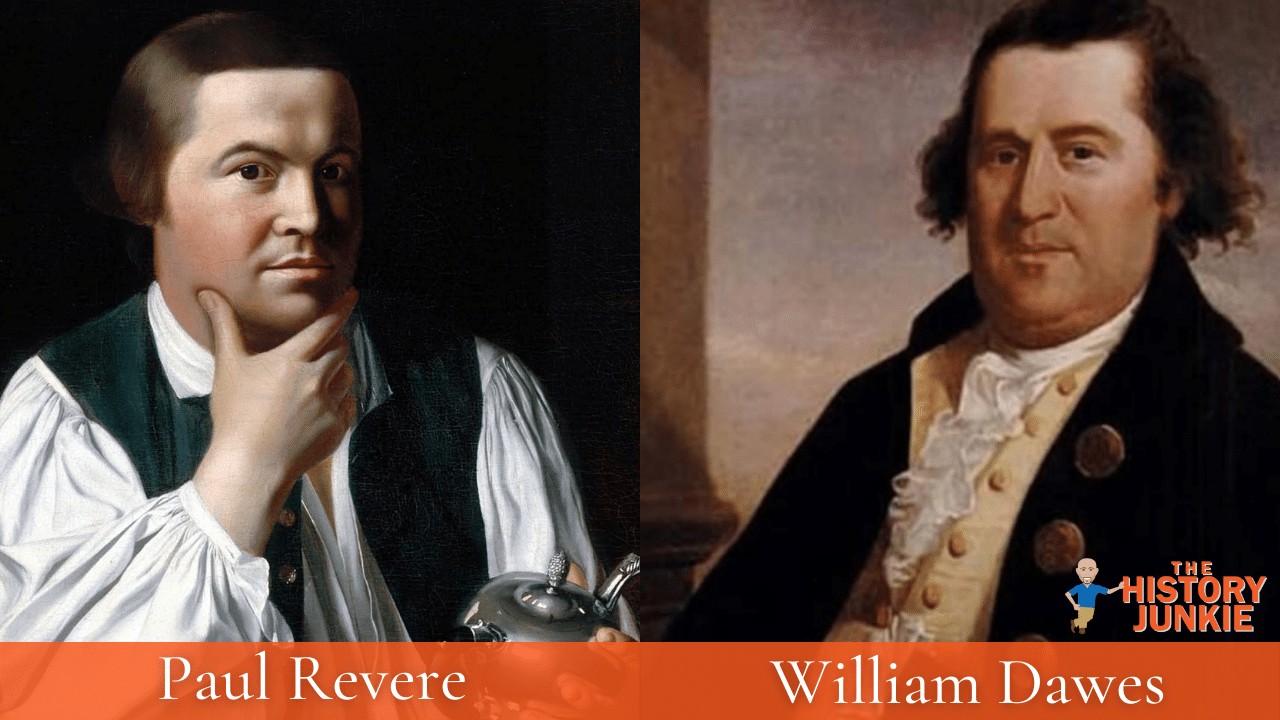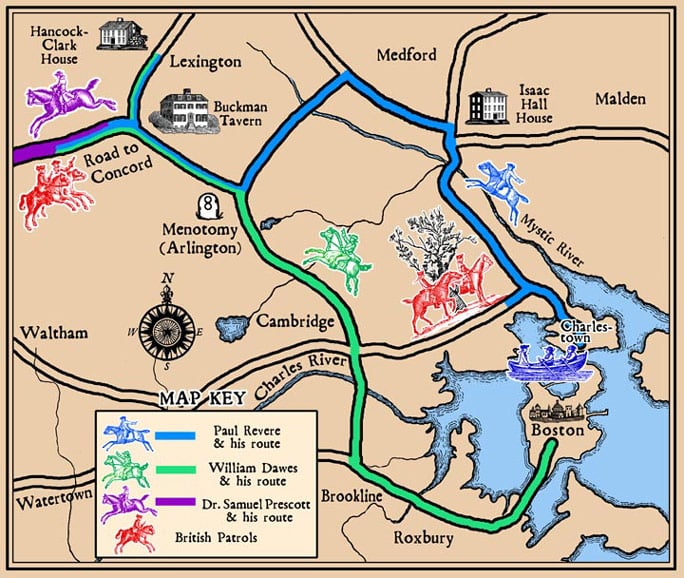One of the questions that arise when studying the early years of the Boston Campaign is the roles of Paul Revere and William Dawes.

Contrary to modern-day, Paul Revere was not a national hero during the American Revolutionary War. He was a well-connected businessman who made a midnight ride to alarm the militia of the British march to Concord, but the hero's of that battle in his day were John Hancock, Samuel Adams, Josiah Bartlett, and John Parker. After the dust of Lexington and Concord settled, the British were bottled in Boston and were put under siege.
Men like William Prescott, Israel Putnam, and Artemis Ward took command of the Boston bands of militia, and Paul Revere went on to have a relatively unknown rest of the war.
While he was still a local hero, he would not become a national legend until Longfellow's poem. When Longfellow penned his famous poem "Paul Revere's Ride," he took a well-known local event, changed the story to create a single hero, and used it as propaganda for the Civil War.
The names of Samuel Prescott, Abel Prescott, Martin Herrick, and, of course, William Dawes were left out, and the poem became infamous. School kids still memorize it as fact and have been told that is how the story really went.
Henry Wadsworth Longfellow should not be blamed for creating a bad history. His intentions were to use the past to promote courage in the present.
He created a fictional account of the ride to drum up support for the Civil War and could have never imagined that his poem would be cited as historical fact. It goes to show how ignorant folks were back then of the ride and that until the poem, Paul Revere was not a well-known figure outside of Boston.
Paul Revere and William Dawes
The two prominent riders of the Midnight Ride took their cues from the influential rebel leader, Joseph Warren. Another name lost in history, Warren was the primary military leader during the early days of Boston and had many connections.
He chose the riders for that night and understood how the strengths of each man that was chosen. Both men had similar tasks but were required to execute them differently.
Paul Revere: Revere was a connector. He was well-known in the community and participated in many rebel groups, such as the Sons of Liberty. He knew the local militia extremely well and had a firm grasp of the terrain.
He was courageous, insubordinate, and a dedicated patriot. It seems as though he knew everyone, and that knowledge allowed him to trigger multiple riders. He was given the northern route, which took him through Charleston, Medford, and eventually to Lexington.
William Dawes: Dawes was equally brave and dedicated to the patriot cause but was not the connector that Paul Revere was.
He was a tanner, and his business frequently took him through the southern route. He not only knew the terrain, but he probably knew the British sentry guards that patrolled the area, and they knew him.
Unlike Revere, he was not as involved in the grassroots of the revolution but was a convenient choice for Warren. His ability to navigate through the southern route without detection was a feat in and of itself.
Compare and Contrast

Northern vs. Southern Route: Each route was dangerous, but the Northern route is believed to be the easiest of the two. Dawes had a longer distance to travel and would come up against more British patrols.
Alarming the Militia: Dawes was not the connector that Revere was. He did not notify anyone of his mission until he reached Adams and Hancock in Lexington.
Revere triggered other riders and militia commanders along his entire route. This is where the distinction between the two should be made. Revere was responsible to initiate the alarm.
By the time he reached Lexington, his actions had already alarmed most of the northern portion of Middlesex County, while the southern portion was fast asleep and had no idea of the march.
Dawes should be noted for his exceptional bravery to carry out the mission, but the actions taken by Revere are the reasons he gets most of the credit.
Post-Lexington: After meeting up with Adams and Hancock, Revere and Dawes took off towards Concord. Along the way, they met up with Samuel Prescott, who was a member of the Sons of Liberty. He agreed to carry the alarm with them.
It was not long after meeting him that the British sentry units saw the three men and began to pursue them. Revere was captured, Dawes was thrown from his horse but managed to escape, and Prescott continued forward carrying the alarm.
Revere would remain in British hands until the British soldiers learned of the provincial resistance. After that, they released him and took off towards the main British line.
Revere returned to Lexington and was in the process of rescuing some documents when the first shots were fired.
Dawes returned home. His ride was finished.
Prescott continued towards Concord and triggered another host of midnight riders. Concord would awake and be prepared for the attack.
Why Does Dawes Get No Respect?
William Dawes is a name often forgotten, while Revere is infamous. While both men died in obscurity, Revere would become immortalized while Dawes would struggle to get any respect.
Some historians do not give him credit for his bravery and suggest that he was just "an ordinary man" while Revere was exceptional. Dawes had the more dangerous route and had to pass through a significant command post to fulfill his mission.
He was successful in completing what he was asked to do and definitely risked his career and life for the cause. So why the lack of respect?
The primary reason for this is due to the poem "Paul Revere's Ride" by Henry Wadsworth Longfellow. As I stated earlier, this poem lifted Revere out of obscurity and made him the singular hero of the story. Dawes was left out, as was Prescott.
The popularity of the poem caused many to take a fictional account of what happened and teach it as fact.
A secondary reason was due to Revere alarming so many others while Dawes simply rode to the meeting house where Hancock and Adams were staying. Simply does not imply it was easy, but Dawes was not the connector the Revere was, and it showed during their rides.
The towns Dawes rode through would not be alarmed by the British movement until Prescott triggered other riders in Concord who completed a full circle around Middlesex County.
By the time Revere reached Lexington, multiple militia units had already alerted and were beginning to muster.
A tertiary reason is due to Paul Revere's popularity with the locals. Everyone knew the work of Revere as a silversmith, and the famous image picturing the Boston Massacre was created by his own hand.
He was involved in many different groups throughout the county and was a well-connected freemason.
Lastly, Dawes died in 1799, while Revere lived 20 years longer. At the time of Revere's death, he was a wealthy businessman and known as a visionary.
He remained active in politics, while Dawes did not.
Conclusion
Paul Revere and William Dawes were both patriots, and both deserve credit where credit is due. Revere deserves credit for his bravery and his ability to connect with others, while Dawes deserves credit for his bravery and ability to fulfill the objective of the mission.
Each man served his country, and each man deserves credit for their sacrifice.
William Dawes should be remembered for his courage, love of family and country, and his ingenuity. He was a successful businessman, a devoted husband, and a loving father.
The notion that one deserves more credit than the other is absurd. It is not a competition, but rather, we need to appreciate what the man accomplished for their country.
